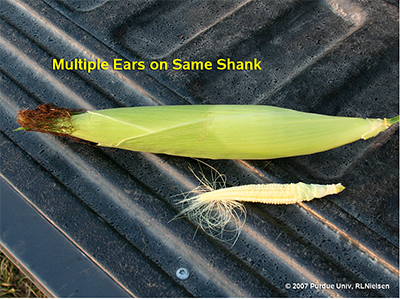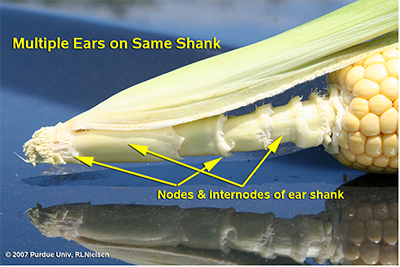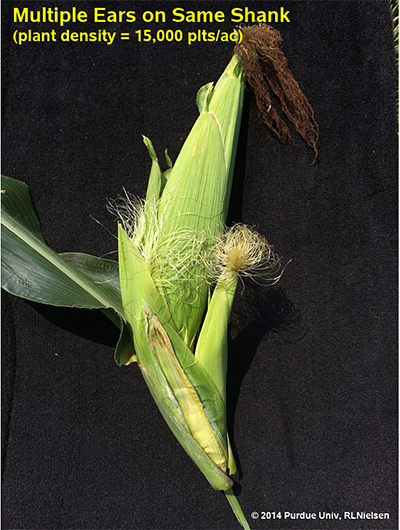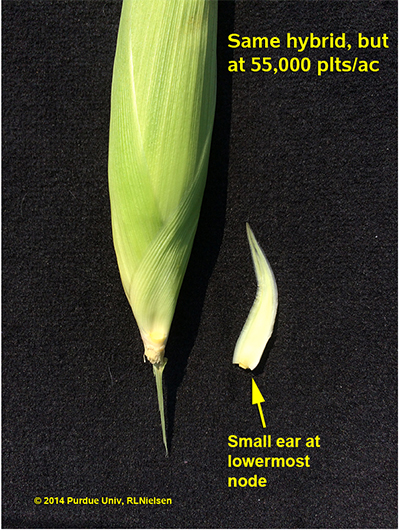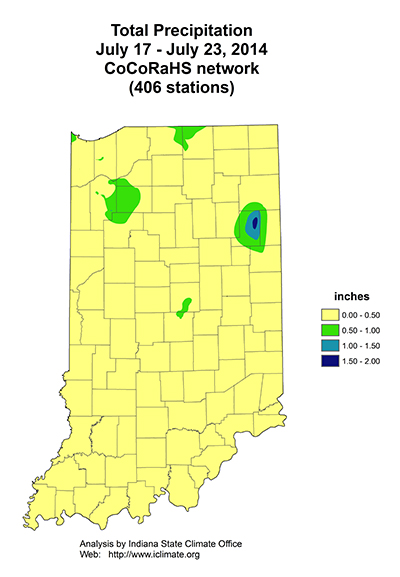USDA-NIFA Extension IPM Grant
Pest & Crop Newsletter, Entomology Extension, Purdue University
Corn Foliar Disease Update – (Kiersten Wise)
Much of Indiana has experienced mild and humid weather over the past few weeks, which has influenced disease development. Gray leaf spot levels have been at low to moderate levels in most areas, but northern corn leaf blight has developed rapidly across Indiana. The high humidity and heavy dews have contributed to disease development, and in some fields the disease is at concerning levels.
Although current corn economics may make some farmers hesitant to spray fungicides, it is important to scout fields and determine if northern corn leaf blight is present in susceptible hybrids in high-risk fields for disease development, such as those that are in minimum or no-till or continuous corn. Although there are not robust thresholds in place for how much disease needs to be present to justify a fungicide application, threshold considerations and fungicide recommendations are discussed in a previous article <http://extension.entm.purdue.edu/pestcrop/2014/issue13/index.html#foliar>.
There are several races of the fungus that causes northern corn leaf blight, and race type can influence symptom expression. We have not examined what races are currently problematic in Indiana, but if you are seeing the disease in hybrids that are considered resistant to northern corn leaf blight, please let us know.
For more information on northern corn leaf blight, please read Purdue Extension bulletin BP-084-W: <http://www.extension.purdue.edu/extmedia/BP/BP-84-W.pdf>.

Northern corn leaf blight
![]()
VIDEO: Northern Corn Leaf Blight – (Kiersten Wise and John Obermeyer) –
Northern corn leaf blight has developed rapidly across Indiana. The high humidity and heavy dews have contributed to disease development, and in some fields the disease is at concerning levels. This video discusses diagnosis and management of this fungal disease.
Click on graphic to see the video.
VIDEO: Northern Corn Leaf Blight
![]()
![]()
Click here to see the 2014 Corn Earworm Trap Report
![]()
Western Bean Cutworm Adult Pheromone Trap Report
![]()
Multiple Ears of Corn on the Same Shank – (Bob Nielsen) -
Most everyone knows that a corn plant initiates a lot of ears, one at every stalk node up to the one that becomes the harvestable one (Nielsen, 2007). Keen observers of the corn plant also recognize that multiple ears can also be found on the same ear shank. Bonnet (1966) briefly mentions this phenomenon and includes a photo in his classic publication that describes the development of inflorescences of major grass crop species. For what it is worth, I mentioned it myself fifteen years ago (Nielsen, 1999) and coined the term “MESS Syndrome” (Multiple Ears on Same Shank).
The fact that multiple ears sometimes develop from a single ear shank is not, in and of itself, physiologically unusual. Ear shank development essentially replicates the developmental pattern of the main stalk of the plant.
Fig. 1. Example of MESS syndrome
Fig. 2. Primary and secondary ear from same shank
Fig. 3. Illustration of shank nodes and internodes, plus secondary ear
- The ear shank is comprised of nodes and internodes just like the main stalk (Fig. 3).
- Each node of an ear shank develops a leaf just like the main stalk, although we add the adjective “husk” to describe them.
- The ear shank terminates with a reproductive organ (the female ear), akin to the main stalk terminating with a reproductive organ (the male tassel).
- Secondary ear shoots can develop from individual nodes of the ear shank just like secondary ear shoots develop from individual nodes of the main stalk.
Normally, hormonal apical dominance exhibited by the primary or apical ear on an ear shank (or simple competition for photosynthates) suppresses the initiation or development of secondary ears at lower shank nodes. However, under certain conditions or with certain genetic backgrounds, one or more secondary ear shoots not only initiate successfully, but also continue to develop to the point that their presence is clearly noticeable. While the appearance of one or more additional ear shoots with silks emerging from lower husk leaves may not be attractive, I do not believe there is any real detriment to the plant by their existence as long as the primary ear is “normal”.
Occasionally, the development of multiple ears on individual ear shanks “blossom” out of proportion (pun intended). Back in 2006, there was a rash of reports from cornfields throughout Indiana and Illinois of an odd multiple-eared phenomenon that I termed the “bouquet” effect (Nielsen, 2006). The characteristic of the “bouquet” effect was a dramatic development of multiple ear shoots from a single ear shank and, in the worst cases, none of the ears successfully pollinated or set kernels. The common factor in affected fields was some sort of damage to the development of the primary ear prior to or during silking that seemed to “set loose” the continued development of the secondary ears on the same ear shank.
A good friend of mine in the seed corn industry asked recently whether today’s hybrids, being bred increasingly for higher plant densities, are more prone to this MESS syndrome when grown at lower plant densities than older hybrids that were more adapted to lower plant densities. I do not know the answer to that question, but I just happen to have one of these so-called “high plant density” hybrids in seeding rate demo plots at the Purdue Agronomy Farm and so went out to look at it the other day.
Sure enough, the plants in the demo plot planted at 15,000 seeds per acre in 15-inch rows were exhibiting the MESS Syndrome with one or two secondary ear shoots clearly visible from the primary ear shank (Fig. 4). It is also true that most of the plants at this low plant density were exhibiting more traditional secondary ears at stalk nodes below the primary ear. However, the MESS Syndrome was also evident in the demo plot planted to 55,000 seeds per acre in 15-inch rows, but at significantly less pronounced levels (Fig. 5).
By itself, this demo plot does not answer the question about hybrids bred for high density and their propensity for the MESS Syndrome relative to other hybrids. I suspect that some genetic backgrounds are simply more prone to this type of multiple ear development and that certain growing conditions encourage the MESS Syndrome with these hybrids.
Fig. 4. MESS syndrome on plant at low density
Fig. 5. MESS syndrome on plant at high density
Related References
Bonnet, O.T. 1966. Inflorescences of Maize, Wheat, Rye, Barley, and Oats: Their Initiation and Development. Univ. of Illinois, College of Ag., Agricultural Expt. Sta. Bulletin 721.
Nielsen, R.L. (Bob). 1999. What A MESS! (aka Multiple Ears on a Single Ear Shank). Corny News Network, Purdue Univ. <http://www.kingcorn.org/news/articles.99/990823b.html>. (URL accessed July 2014).
Nielsen, R.L. (Bob). 2006. A Problem with “Bouquets”. Corny News Network, Purdue Univ. <http://www.kingcorn.org/news/articles.06/Bouquets-0912.html>. (URL accessed July 2014).
Nielsen, R.L. (Bob). 2007. Ear Size Determination in Corn. Corny News Network, Purdue Univ. <http://www.kingcorn.org/news/timeless/EarSize.html>. (URL accessed July 2014).
Nielsen, R.L. (Bob). 2011. Kernel Set Scuttlebutt. Corny News Network, Purdue Univ. <http://www.kingcorn.org/news/timeless/KernelSet.html>. (URL accessed July 2014).
![]()
Cool Temperatures & Grain Yield: Déjà vu for Corn? – (Bob Nielsen)
Global warming aside, much of Indiana has experienced a cool summer to date (Fig. 1). As Yogi Berra once said, “It’s like déjà vu all over again” relative to the questions folks have been asking recently about the consequences, good or bad, of such cool temperatures on the prospects for corn grain yields at harvest this fall. Similar questions were raised only a few years ago (2009) in another recent cool growing season (Nielsen, 2009).
So............. what about the 2014 growing season and its cool temperatures? One needs to be cautious making comparisons with the 2009 growing season, especially with regard to the unpleasant harvesting experience of 2009.
Certainly, both growing seasons were cool through to about this time in July (Fig’s 1 & 2), and 2009 continued to be cool throughout much of the remaining part of that summer (Fig. 2) and into early fall. However, corn planting statewide was considerably delayed in 2009 versus the 5-year average (Fig. 3). Early season cool temperatures in 2009 sustained the delayed crop progress, resulting in about a 7-day later statewide silking period in 2009 versus the 5-year average (Fig. 4). Subsequent cool temperatures in August and September further delayed grain maturity in 2009 to nearly two weeks later than the 5-year average (Fig. 5). Coupled with poor conditions for grain drying in the field prior to harvest plus the development of ear rots and mycotoxins, grain harvest was pretty miserable for many growers in 2009. Nevertheless, estimated statewide grain yield in Indiana for 2009 set a new state record at 171 bu/ac that was not exceeded until last year’s record yield of 177 bu/ac (USDA-NASS, 2014b).
Fig. 1. Daily rainfall and max/min air temperatures for June and July, 2014 in westcentral Indiana. Source of graph: Midwest Regional Climate Center.
Fig. 2. Daily rainfall and max/min air temperatures for June through August, 2009 in westcentral Indiana. Source of graph: Midwest Regional Climate Center.
Fig. 3. Planting progress of corn in Indiana for 2014 and select years. Data: USDA-NASS
So........... again, the question lingers about the 2014 growing season and its cool temperatures to date. The honest answer to that question is..... “time will tell”, because the next 60 days will decide whether this crop finishes as strong as much of it looks today or falters in response to yet unknown weather extremes and/or diseases.
Fig. 4. Silking progress of corn in Indiana for 2014 (as of 7/20) and select years. Data: USDA-NASS. Data: USDA-NASS
Fig. 5. Grain maturity progress of corn in Idnaian for select years. Data: USDA-NASS
The good news
• While the onset of planting was delayed in 2014, the majority of the crop was planted ahead of the 5-year average pace (Fig. 3), in contrast to the overwhelming late planting of 2009.
• While the cool temperatures to date most certainly have slowed the progress of the crop, the statewide pace of silking (as of 20 July) remains slightly ahead of the 5-year average (Fig. 4).
• Stand establishment (plant population and initial uniformity) appears to have been excellent throughout the state, except for fields or areas within fields that sustained damage from excessive rainfall earlier in the season.
• Moderate temperatures and, mostly, adequate soil moisture during this critical pollen shed and silking period have certainly been favorable for successful pollination and kernel set.
• The current monthly weather outlooks for August through September for Indiana (NWS, 2014) suggest “normal” temperatures (not excessively hot or excessively cool) and normal rainfall (not excessively wet or excessively dry), which would certainly bode well for the important grain filling period (kernel weight) and for minimizing the risk of further delay in the progress of the crop as it moves toward maturity.
• Foliar disease levels, to date, remain moderate in most fields with some exceptions.
• Many of the record high corn grain yield years in Indiana have been those with moderate, if not cool, temperatures during the growing season.
Potential bad news
• Any potential bad news depends on weather, diseases (including ear rots), and the adequacy of soil nitrogen for finishing the crop without any undue photosynthetic stress during the grain filling period (Nielsen, 2014).
Click on images to view larger versions. NOTE OF CAUTION: The first two graphs were auto-generated on the MRCC Web site. The temperature and rainfall axis scales differ slightly for each year’s graph, so be careful when visually comparing one year with the other.
Related Reading
MRCC. 2014. cli-MATE Database. Midwest Regional Climate Center, Champaign, IL. <http://mrcc.isws.illinois.edu/CLIMATE>. [URL accessed July 2014].
NWS. 2014. Climate Prediction Center. National Weather Service. <http://www.cpc.ncep.noaa.gov/index.php>. [URL accessed July 2014].
Nielsen, RL (Bob). 2009. Cool Temperatures: Good News or Bad News for Corn? Corny News Network, Purdue Extension. <http://www.kingcorn.org/news/articles.14/YieldProspects-0715.html>. [URL accessed July 2014].
Nielsen, RL (Bob). 2014. Prospects for the 2014 Indiana Corn Crop. Corny News Network, Purdue Extension. <http://www.kingcorn.org/news/articles.09/GoodNewsBadNews-0721.html>. [URL accessed July 2014].
USDA-NASS. 2014a. Crop Production Annual Summary. USDA National Agricultural Statistics Service. <http://usda.mannlib.cornell.edu/MannUsda/viewDocumentInfo.do?documentID=1047>. [URL accessed July 2014].
USDA-NASS. 2014b. Crop Progress. USDA National Agricultural Statistics Service. <http://usda.mannlib.cornell.edu/MannUsda/viewDocumentInfo.do?documentID=1048 >.[URL accessed July 2014].
![]()


